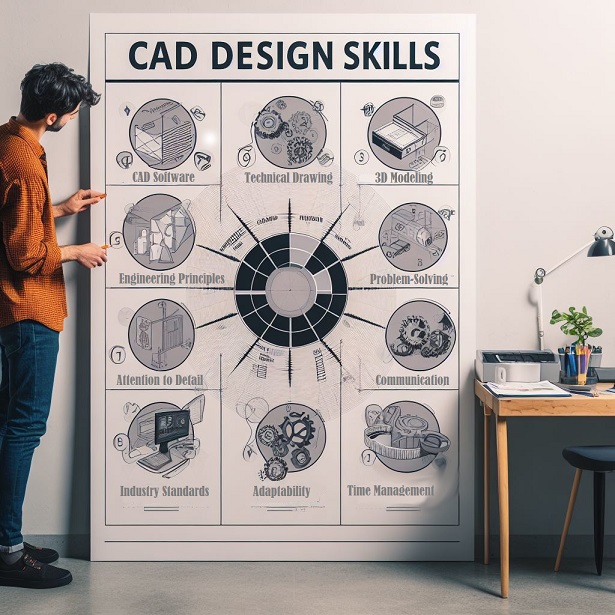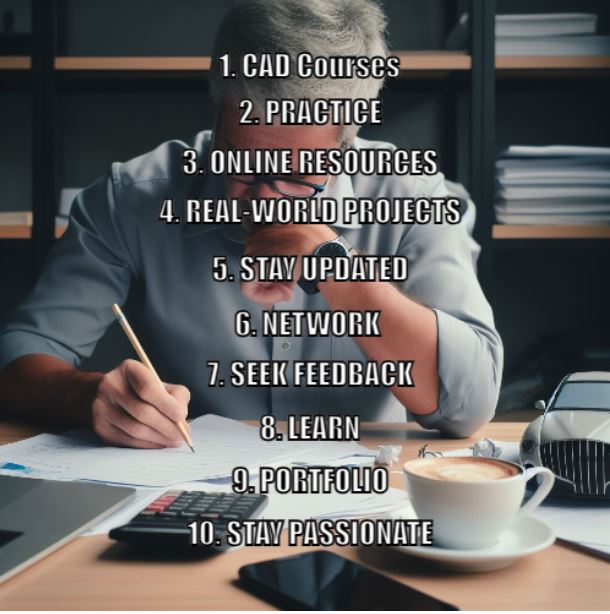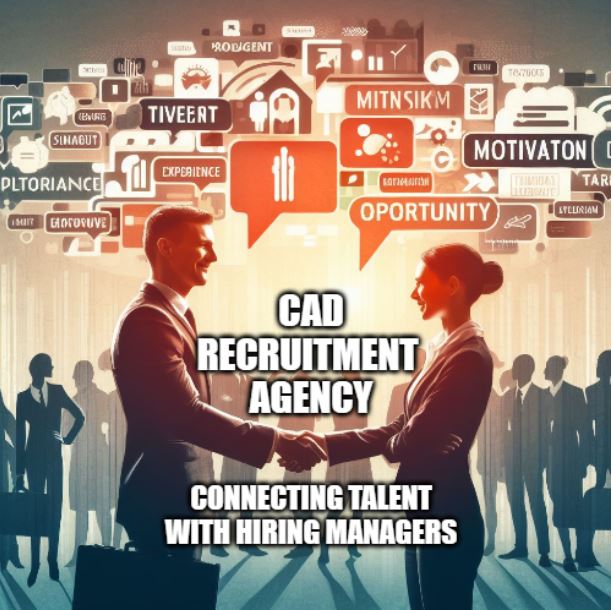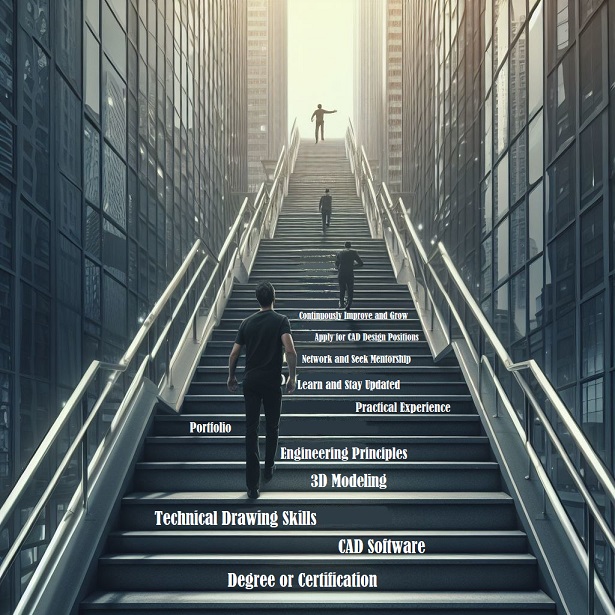| Topic | Summary |
|---|---|
| Top CAD Design Skills in Demand | Proficiency in CAD software, technical drawing, 3D modeling, knowledge of engineering principles, problem-solving skills, attention to detail, collaboration and communication abilities, knowledge of industry standards, adaptability, and time management. |
| Improving CAD Design Skills | Take CAD design courses, practice regularly, explore online resources, work on real-world projects, stay updated with software, network with CAD professionals, seek feedback, continuously learn, build a portfolio, and stay passionate. |
| Industries Requiring CAD Design Skills | Architecture and construction, engineering, manufacturing, product design, civil and structural engineering, automotive, aerospace, electronics, interior design, and industrial design. |
| Role of CAD Recruitment Agencies | Access to talent, specialized knowledge, efficient hiring processes, industry connections, flexible staffing solutions, market insights, and long-term partnerships. |
| Benefits of Hiring a CAD Design Specialist | Expertise in CAD software, time and cost savings, improved design quality, enhanced collaboration, innovation and problem-solving, efficient design iterations, visualization and simulation capabilities, adherence to industry standards, increased productivity, competitive advantage, long-term value, and continuous learning and growth. |
| Future Trends in CAD Design | Generative design, cloud-based CAD, virtual and augmented reality, simulation and analysis, integration with IoT, parametric and generative design, additive manufacturing, AI assistance, design for sustainability, and collaborative design platforms. |
| Advantages of Outsourcing CAD Design Services | Cost savings, access to specialized skills, flexibility and scalability, focus on core competencies, reduced turnaround time, access to advanced tools and technologies, risk mitigation, international market reach, improved design quality, and long-term partnership opportunities. |
| Challenges Faced by CAD Designers | Complex design requirements, meeting tight deadlines, design changes and revisions, collaboration and communication, software and technology updates, design validation and testing, managing large and complex projects, keeping up with industry trends, intellectual property protection, and work-life balance. |
| Future Outlook for CAD Design Careers | Technological advancements, industry demand, globalization, sustainable design, additive manufacturing, automation and efficiency, continued learning and adaptation. |
| Staying Competitive as a CAD Design Specialist | Continued learning, specialization in a niche, building a strong portfolio, networking and collaboration, seeking professional certifications, staying versatile and adaptable, developing soft skills, staying updated with industry news, seeking feedback and continuous improvement, and staying passionate and curious. |
1. What are the top CAD design skills in demand?

When it comes to CAD (Computer-Aided Design), there are several skills that are highly sought after in the industry. These skills not only make you a valuable asset to employers but also enhance your career prospects. Here are the top CAD design skills in demand:
- Proficiency in CAD Software: The most essential skill is a deep understanding and proficiency in CAD software such as AutoCAD, SolidWorks, CATIA, or Revit. Employers look for candidates who can effectively navigate and utilize these tools to create accurate and detailed designs.
- Technical Drawing: The ability to create precise technical drawings is crucial in CAD design. This includes skills in orthographic projection, isometric drawing, dimensioning, and geometric tolerancing.
- 3D Modeling: Proficiency in 3D modeling is highly valued in the industry. Being able to create realistic and detailed 3D models using CAD software allows for better visualization and analysis of designs.
- Knowledge of Engineering Principles: Understanding engineering principles and concepts is essential for CAD designers. This includes knowledge of materials, structural analysis, mechanical systems, and manufacturing processes.
- Problem-Solving Skills: CAD designers often encounter complex design challenges that require innovative solutions. Having strong problem-solving skills and the ability to think critically is highly valued.
- Attention to Detail: In CAD design, precision and accuracy are paramount. Employers seek candidates who have a keen eye for detail and can produce designs that meet strict specifications.
- Collaboration and Communication: CAD designers often work in teams and need to effectively communicate their ideas and designs. Strong collaboration and communication skills are essential for successful project completion.
- Knowledge of Industry Standards: Staying up-to-date with industry standards and best practices is crucial. Employers look for candidates who are familiar with relevant codes, regulations, and standards in their specific field.
- Adaptability and Continuous Learning: CAD design is a rapidly evolving field, and employers value candidates who are adaptable and willing to learn new software and techniques as technology advances.
- Time Management: Meeting deadlines is crucial in CAD design. Being able to effectively manage time and prioritize tasks is a skill that employers highly value.
By developing and showcasing these top CAD design skills, you can position yourself as a highly sought-after professional in the industry.
2. How can I improve my CAD design skills?

Improving your CAD design skills requires dedication and continuous learning. Here are some effective ways to enhance your skills:
- Take CAD Design Courses: Enroll in CAD design courses or certification programs to gain formal training and learn industry best practices. These courses often cover software proficiency, technical drawing, 3D modeling, and other essential skills.
- Practice Regularly: The more you practice, the better you become. Set aside dedicated time to work on CAD design projects, whether it’s creating 2D drawings or complex 3D models. This will help you refine your skills and gain confidence.
- Explore Online Resources: There are numerous online tutorials, forums, and communities dedicated to CAD design. Take advantage of these resources to learn new techniques, troubleshoot issues, and stay updated with the latest trends in the industry.
- Work on Real-World Projects: Seek opportunities to work on real-world CAD design projects. This could be through internships, freelance work, or collaborating with professionals in the field. Practical experience will enhance your skills and provide valuable insights.
- Stay Updated with Software: CAD software is constantly evolving, with new features and updates being released regularly. Stay updated with the latest versions of the software you use and explore new tools and functionalities. This will ensure you are utilizing the software to its full potential.
- Network with CAD Professionals: Attend industry events, join professional organizations, and connect with CAD professionals. Networking can provide valuable opportunities to learn from experienced designers, gain insights into industry trends, and potentially find mentorship.
- Seek Feedback: Share your work with peers, mentors, or professionals in the field and ask for constructive feedback. Feedback can help you identify areas for improvement and provide guidance on how to enhance your CAD design skills.
- Continuously Learn: CAD design is a field that requires continuous learning. Stay curious and explore new techniques, software, and design methodologies. Engage in lifelong learning to stay ahead in the industry.
- Build a Portfolio: Create a portfolio showcasing your best CAD design work. This will not only demonstrate your skills to potential employers but also serve as a visual representation of your growth and capabilities as a CAD designer.
- Stay Passionate: Passion is a driving force for improvement. Stay passionate about CAD design and immerse yourself in the field. The more you enjoy what you do, the more motivated you will be to continuously improve your skills.
By following these strategies, you can effectively improve your CAD design skills and stand out in the competitive job market.
3. What industries require CAD design skills?
CAD design skills are in demand across various industries. Here are some industries that heavily rely on CAD design:
| 1. Architecture and Construction | 6. Automotive |
| 2. Engineering | 7. Aerospace |
| 3. Manufacturing | 8. Electronics |
| 4. Product Design | 9. Interior Design |
| 5. Civil and Structural Engineering | 10. Industrial Design |
In these industries, CAD design is used for various purposes, including creating architectural plans, designing mechanical components, visualizing product prototypes, and developing electrical schematics. CAD designers play a crucial role in bringing ideas to life and ensuring accurate and efficient design processes.
4. What is the role of CAD recruitment agencies in shaping modern engineering?

CAD recruitment agencies play a significant role in shaping modern engineering by connecting talented CAD professionals with top companies in need of their skills. Here are some key ways in which CAD recruitment agencies contribute to the engineering industry:
- Access to Talent: CAD recruitment agencies have extensive networks and databases of skilled CAD professionals. They help companies access a wide pool of talent, including both active job seekers and passive candidates who may not be actively looking for new opportunities.
- Specialized Knowledge: CAD recruitment agencies have a deep understanding of the CAD industry and the specific skills required for different roles. They can provide valuable insights and guidance to both candidates and employers, ensuring the right match between skills and job requirements.
- Efficient Hiring Process: CAD recruitment agencies streamline the hiring process by pre-screening candidates, conducting interviews, and assessing their technical skills. This saves time and effort for companies, allowing them to focus on their core business activities.
- Industry Connections: Recruitment agencies have established relationships with companies in the engineering industry. They are aware of upcoming projects, job openings, and industry trends. This knowledge enables them to connect candidates with the right opportunities and provide companies with access to top talent.
- Flexible Staffing Solutions: CAD recruitment agencies offer flexible staffing solutions to meet the dynamic needs of engineering companies. They can provide temporary, contract, or permanent placements based on the specific requirements of the company.
- Market Insights: Recruitment agencies stay updated with market trends, salary benchmarks, and industry demands. They can provide valuable insights to both candidates and employers, helping them make informed decisions and stay competitive.
- Long-Term Partnerships: CAD recruitment agencies aim to build long-term partnerships with both candidates and employers. They provide ongoing support, career guidance, and assistance with talent acquisition, contributing to the growth and success of the engineering industry.
In summary, CAD recruitment agencies play a vital role in connecting talent with opportunities, ensuring efficient hiring processes, and providing industry expertise to shape modern engineering.
5. What are the benefits of hiring a CAD design specialist?
Hiring a CAD design specialist can bring numerous benefits to your company. Here are some key advantages:
- Expertise in CAD Software: CAD design specialists have extensive knowledge and expertise in CAD software. They can efficiently navigate and utilize the software’s features to create accurate and detailed designs.
- Time and Cost Savings: CAD design specialists are skilled in creating efficient and optimized designs. This can result in time and cost savings during the design and manufacturing processes.
- Improved Design Quality: CAD design specialists have the expertise to create high-quality designs that meet industry standards and specifications. Their attention to detail and understanding of engineering principles ensure that the designs are accurate and functional.
- Enhanced Collaboration: CAD design specialists are adept at collaborating with other team members, such as engineers, architects, and manufacturers. They can effectively communicate their design ideas and make necessary adjustments based on feedback, leading to improved collaboration and project outcomes.
- Innovation and Problem-Solving: CAD design specialists have the ability to think creatively and find innovative solutions to design challenges. They can analyze complex problems and develop unique design solutions that meet the project requirements.
- Efficient Design Iterations: CAD design specialists can quickly iterate and modify designs based on feedback and changes in project requirements. This agility allows for faster design iterations and reduces the time required to finalize designs.
- Visualization and Simulation: CAD design specialists can create realistic 3D models and visualizations of designs. This allows stakeholders to better understand the design concept and make informed decisions. Additionally, CAD software often includes simulation capabilities, enabling specialists to analyze the performance and behavior of the design before manufacturing.
- Adherence to Industry Standards: CAD design specialists are knowledgeable about industry standards and regulations. They ensure that the designs comply with these standards, reducing the risk of errors or non-compliance.
- Increased Productivity: By hiring a CAD design specialist, companies can focus on their core competencies while leaving the design work to an expert. This increases overall productivity and allows employees to allocate their time and resources more efficiently.
- Competitive Advantage: Having a CAD design specialist on your team gives your company a competitive edge. High-quality designs, efficient processes, and innovative solutions can differentiate your products or services in the market.
- Long-Term Value: Investing in a CAD design specialist can provide long-term value to your company. Their expertise and skills can contribute to the success of multiple projects and ensure consistent design quality over time.
- Continuous Learning and Growth: CAD design specialists are committed to continuous learning and staying updated with the latest advancements in CAD software and design techniques. Their growth mindset and willingness to adapt to new technologies can drive innovation within your company.
In conclusion, hiring a CAD design specialist offers numerous benefits, including expertise in CAD software, time and cost savings, improved design quality, enhanced collaboration, innovation and problem-solving, efficient design iterations, visualization and simulation capabilities, adherence to industry standards, increased productivity, competitive advantage, long-term value, and continuous learning and growth.
6. How can I become a CAD design specialist?

Becoming a CAD design specialist requires a combination of education, training, and practical experience. Here are the steps you can take to pursue a career as a CAD design specialist:
- Earn a Degree or Certification: Start by obtaining a degree or certification in a relevant field such as mechanical engineering, industrial design, or architecture. This will provide you with a strong foundation in design principles and engineering concepts.
- Gain Proficiency in CAD Software: Familiarize yourself with industry-standard CAD software such as AutoCAD, SolidWorks, or CATIA. Take courses or online tutorials to develop your skills and become proficient in using these tools.
- Develop Technical Drawing Skills: Master technical drawing techniques such as orthographic projection, isometric drawing, and dimensioning. Practice creating accurate and detailed technical drawings to enhance your skills in this area.
- Learn 3D Modeling: Gain expertise in 3D modeling techniques using CAD software. Learn how to create realistic and detailed 3D models of objects, products, or architectural designs.
- Understand Engineering Principles: Develop a solid understanding of engineering principles and concepts. Learn about materials, structural analysis, mechanical systems, and manufacturing processes to create designs that are functional and efficient.
- Build a Portfolio: Create a portfolio showcasing your CAD design work. Include a variety of projects that highlight your skills and demonstrate your ability to create high-quality designs.
- Gain Practical Experience: Seek internships, co-op programs, or entry-level positions that allow you to gain practical experience in CAD design. This will provide you with real-world exposure and help you develop your skills further.
- Continuously Learn and Stay Updated: CAD design is a rapidly evolving field, so it’s important to stay updated with the latest software updates, industry trends, and design methodologies. Engage in continuous learning through courses, workshops, and online resources.
- Network and Seek Mentorship: Connect with professionals in the CAD design industry through networking events, professional organizations, and online communities. Seek mentorship from experienced CAD designers who can provide guidance and advice.
- Apply for CAD Design Positions: Once you have developed your skills and gained practical experience, start applying for CAD design positions. Tailor your resume and portfolio to highlight your relevant experience and skills.
- Continuously Improve and Grow: As a CAD design specialist, strive for continuous improvement and growth. Seek feedback on your work, stay curious, and embrace new technologies and design methodologies.
By following these steps and continuously honing your skills, you can become a successful CAD design specialist.
7. What are the future trends in CAD design?
The field of CAD design is constantly evolving, driven by advancements in technology and changing industry demands. Here are some future trends that are shaping the CAD design industry:
- Generative Design: Generative design uses algorithms and artificial intelligence to create optimized designs based on specified parameters. It allows CAD designers to explore a wide range of design possibilities and find innovative solutions.
- Cloud-Based CAD: Cloud-based CAD platforms enable collaboration, real-time updates, and access to design files from anywhere. This trend allows for seamless collaboration among team members and improves workflow efficiency.
- Virtual and Augmented Reality: Virtual and augmented reality technologies are being integrated into CAD design processes. These technologies allow designers to visualize and interact with their designs in a virtual environment, enhancing the design review and validation process.
- Simulation and Analysis: CAD software is increasingly incorporating simulation and analysis capabilities. This allows designers to evaluate the performance, behavior, and structural integrity of their designs before manufacturing, reducing the risk of errors and optimizing designs.
- Integration with Internet of Things (IoT): CAD design is becoming more integrated with IoT technologies. Designers are creating smart and connected products that can communicate and interact with other devices, leading to the development of innovative and intelligent designs.
- Parametric and Generative Design: Parametric design allows designers to create models with parameters that can be easily modified. Generative design takes this a step further by using algorithms to automatically generate design options based on specified constraints.
- Additive Manufacturing: Additive manufacturing, also known as 3D printing, is revolutionizing the manufacturing industry. CAD designers are leveraging this technology to create complex and customized designs that were previously not feasible with traditional manufacturing methods.
- Artificial Intelligence (AI) Assistance: AI is being integrated into CAD software to assist designers in automating repetitive tasks, suggesting design improvements, and optimizing designs based on predefined objectives.
- Design for Sustainability: There is a growing emphasis on sustainable design practices. CAD designers are incorporating sustainability principles into their designs, such as optimizing material usage, reducing waste, and considering the environmental impact of their designs.
- Collaborative Design Platforms: Collaborative design platforms are emerging, allowing multiple designers to work on the same project simultaneously. These platforms enable real-time collaboration, version control, and seamless communication among team members.
These trends indicate the direction in which CAD design is heading, with a focus on automation, collaboration, optimization, and sustainability.
8. What are the advantages of outsourcing CAD design services?
Outsourcing CAD design services can offer several advantages for companies. Here are some key benefits:
- Cost Savings: Outsourcing CAD design services can be more cost-effective compared to maintaining an in-house design team. Companies can save on recruitment, training, salaries, benefits, and infrastructure costs associated with having an internal design department.
- Access to Specialized Skills: Outsourcing allows companies to tap into a global talent pool and access specialized CAD design skills that may not be available internally. This provides access to a broader range of expertise and ensures high-quality design work.
- Flexibility and Scalability: Outsourcing CAD design services provides flexibility in scaling up or down based on project requirements. Companies can easily adjust the number of resources allocated to CAD design projects without the constraints of hiring or laying off employees.
- Focus on Core Competencies: By outsourcing CAD design services, companies can focus on their core competencies and strategic initiatives. This allows them to allocate resources and attention to areas that directly contribute to their business objectives.
- Reduced Turnaround Time: CAD design service providers often have dedicated teams and streamlined processes, resulting in faster turnaround times for design projects. This can help companies meet tight deadlines and accelerate product development cycles.
- Access to Advanced Tools and Technologies: CAD design service providers invest in the latest software, hardware, and technologies to deliver high-quality designs. By outsourcing, companies can leverage these advanced tools without the need for significant upfront investments.
- Risk Mitigation: Outsourcing CAD design services can help mitigate risks associated with design errors or delays. Service providers often have quality control measures in place to ensure accurate and error-free designs, reducing the risk of costly rework or project delays.
- International Market Reach: Outsourcing CAD design services can provide companies with access to international markets. Service providers may have expertise in specific industries or regions, allowing companies to expand their reach and cater to a broader customer base.
- Improved Design Quality: CAD design service providers specialize in delivering high-quality designs. Their expertise, experience, and quality control processes ensure that the designs meet industry standards and specifications.
- Long-Term Partnership Opportunities: Outsourcing CAD design services can lead to long-term partnerships with reliable service providers. These partnerships can result in a deeper understanding of the company’s design requirements, improved collaboration, and consistent design quality over time.
Overall, outsourcing CAD design services can provide cost savings, access to specialized skills, flexibility, focus on core competencies, reduced turnaround time, access to advanced tools, risk mitigation, international market reach, improved design quality, and long-term partnership opportunities.
9. What are the challenges faced by CAD designers?

CAD designers face several challenges in their work. Here are some common challenges:
- Complex Design Requirements: CAD designers often encounter complex design requirements that require innovative solutions. Balancing functionality, aesthetics, and manufacturability can be challenging, especially when dealing with intricate designs or unique project specifications.
- Meeting Tight Deadlines: CAD designers often work on projects with tight deadlines. This can create pressure to deliver designs quickly while maintaining accuracy and quality. Time management and prioritization skills are crucial to meet project timelines.
- Design Changes and Revisions: Design changes and revisions are common in the CAD design process. Dealing with frequent modifications can be challenging, as it requires adapting designs, managing version control, and ensuring that all stakeholders are aligned.
- Collaboration and Communication: CAD designers often collaborate with other team members, such as engineers, architects, and manufacturers. Effective communication and collaboration can be challenging, especially when working with multidisciplinary teams or when there are language or cultural barriers to overcome.
- Software and Technology Updates: CAD software and technology are constantly evolving, with new updates and features being released regularly. Keeping up with these updates and learning new tools and functionalities can be a challenge for CAD designers, requiring continuous learning and adaptation.
- Design Validation and Testing: Ensuring the accuracy and functionality of designs is crucial. CAD designers face the challenge of validating and testing their designs to ensure they meet industry standards, regulations, and client requirements. This may involve conducting simulations, analysis, and physical testing.
- Managing Large and Complex Projects: CAD designers often work on large-scale projects with complex design requirements. Managing and coordinating multiple design elements, stakeholders, and project timelines can be challenging, requiring effective project management skills.
- Keeping Up with Industry Trends: The CAD design industry is constantly evolving, with new trends, techniques, and technologies emerging. Staying updated with these industry trends and incorporating them into design processes can be a challenge, requiring continuous learning and professional development.
- Design Optimization: Design optimization involves finding the balance between various factors, such as cost, performance, and sustainability. CAD designers face the challenge of optimizing designs to meet these requirements while considering constraints such as material limitations, manufacturing processes, and project budgets.
- Client Expectations and Feedback: Understanding and meeting client expectations can be challenging for CAD designers. Interpreting client requirements, managing feedback, and ensuring client satisfaction requires strong communication and interpersonal skills.
- Intellectual Property Protection: Protecting intellectual property rights can be a challenge for CAD designers, especially when working on sensitive or proprietary designs. Ensuring that designs are secure and confidential requires implementing appropriate security measures and adhering to legal and ethical guidelines.
- Work-Life Balance: CAD designers often work on demanding projects with tight deadlines, which can impact work-life balance. Balancing work commitments with personal life and self-care can be challenging, requiring effective time management and prioritization.
Despite these challenges, CAD designers can overcome them through continuous learning, effective communication, collaboration, adaptability, and a passion for their work.
10. What is the future outlook for CAD design careers?
The future outlook for CAD design careers is promising, with several factors contributing to a positive outlook:
- Technological Advancements: CAD design is constantly evolving with advancements in technology. The integration of artificial intelligence, virtual reality, and cloud-based platforms is transforming the way CAD designers work, opening up new opportunities and enhancing design capabilities.
- Industry Demand: The demand for CAD design professionals remains high across various industries, including architecture, engineering, manufacturing, and product design. As companies continue to innovate and develop new products, the need for skilled CAD designers will continue to grow.
- Globalization: Globalization has led to increased collaboration and outsourcing of CAD design services. This creates opportunities for CAD designers to work on international projects and collaborate with teams from different parts of the world.
- Sustainable Design: There is a growing emphasis on sustainable design practices, driven by environmental concerns and regulations. CAD designers who have expertise in sustainable design principles and can create eco-friendly designs will be in high demand.
- Additive Manufacturing: The rise of additive manufacturing, or 3D printing, is creating new opportunities for CAD designers. The ability to design complex and customized products for additive manufacturing is a valuable skill in the industry.
- Automation and Efficiency: CAD design is becoming more automated and efficient with the use of generative design algorithms and AI-assisted tools. CAD designers who can leverage these technologies to streamline design processes and optimize designs will be highly sought after.
- Continued Learning and Adaptation: CAD designers who embrace continuous learning and stay updated with the latest software, tools, and design methodologies will have a competitive edge in the job market. The ability to adapt to changing technologies and industry trends is crucial for long-term career success.
Overall, the future outlook for CAD design careers is promising, with opportunities for growth, innovation, and specialization. By staying current with industry trends and continuously developing their skills, CAD designers can position themselves for a successful and fulfilling career.
11. How can a CAD design specialist stay competitive in the job market?

To stay competitive in the job market as a CAD design specialist, it’s important to continuously develop and showcase your skills. Here are some strategies to stay competitive:
- Continued Learning: Stay updated with the latest advancements in CAD software, design techniques, and industry trends. Take advantage of online courses, workshops, and professional development opportunities to expand your knowledge and skills.
- Specialize in a Niche: Consider specializing in a specific niche within CAD design, such as automotive design, architectural visualization, or industrial machinery design. Developing expertise in a specialized area can make you a sought-after professional in that field.
- Build a Strong Portfolio: Continuously update and enhance your portfolio to showcase your best work. Include a variety of projects that demonstrate your skills, creativity, and problem-solving abilities. Tailor your portfolio to highlight your expertise in specific industries or design areas.
- Network and Collaborate: Attend industry events, join professional organizations, and connect with other CAD design professionals. Networking can lead to valuable connections, collaboration opportunities, and potential job leads.
- Seek Professional Certifications: Consider obtaining professional certifications in CAD design. Certifications such as Autodesk Certified Professional or SolidWorks Certified Professional can validate your skills and enhance your credibility in the job market.
- Stay Versatile and Adaptable: Be open to learning new CAD software, tools, and design methodologies. The ability to adapt to different software platforms and design requirements makes you more versatile and valuable to employers.
- Develop Soft Skills: In addition to technical skills, employers value CAD designers who possess strong communication, problem-solving, and teamwork skills. Develop your soft skills to effectively collaborate with team members, communicate your design ideas, and adapt to project requirements.
- Stay Updated with Industry News: Stay informed about industry news, emerging technologies, and design trends. Subscribe to industry publications, follow influential CAD design blogs, and engage in online communities to stay updated and contribute to industry discussions.
- Seek Feedback and Continuous Improvement: Actively seek feedback on your work from peers, mentors, or industry professionals. Use feedback as an opportunity for growth and improvement. Continuously strive to enhance your skills and refine your design processes.
- Stay Passionate and Curious: Maintain a passion for CAD design and stay curious about new technologies and design possibilities. A genuine enthusiasm for your work will drive you to continuously learn, innovate, and stay ahead in the job market.
By implementing these strategies, you can stay competitive as a CAD design specialist and position yourself for exciting career opportunities.
